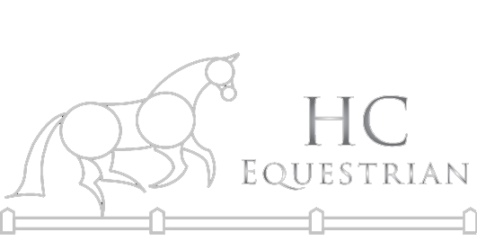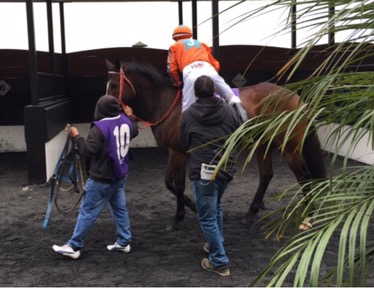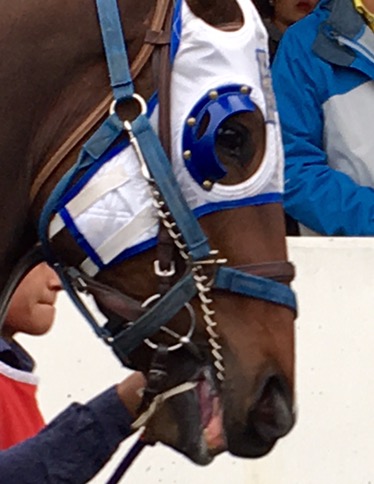Like many riders, I have more skill than confidence. I wish it were the other way around. I’ve seen lots of riders with more confidence than skill, and most of the time they are having way more fun than their worried counterparts.
In my observations, the more confident riders don’t get hurt as much as the more skilled riders. I chalk this up to the horse feeding off the confidence of their rider and being happy with having a strong leader.
For my confidence, some days are better than others. After a couple decades of anxiety in the saddle, I’ve learned some ways to recapture that golden snitch of confidence.
 Yep, that’s the face I make when trying to get my confidence back
Yep, that’s the face I make when trying to get my confidence back
Just Say No
As a professional, my job is to ride horses that require a professional ride. Since I began working for myself ten years ago, I’ve said no to several requests to ride horses I didn’t feel confident about riding. Saying no is unfortunately a career limiting move when working for someone else, but it has far less repercussions when self employed. For most riders, fun is the primary objective. Getting in the saddle should be something to look forward to, not dread.
Ride someone else
If you feel anxious riding Dobbin, perhaps you should ride Cupcake for a little while. Even if you own Dobbin, riding a horse that is steadier will help steady your nerves. This is especially true after taking a break from riding. I inexplicably lost some confidence last week, so now that Corny is ready to be ridden, I owed it to him to be a confident leader. I was able to get a good ride on River in to boost my confidence.
River has been in training with me for about a year. He’s never done anything I couldn’t easily handle when riding him. That makes him a great choice for my confidence boosting horse.
My confidence building ride on River.
Mitigate your pain
It is tough to be brave when you feel pain. Typically, we tend to guard ourselves and protect our injured parts. This makes harmony with the horse challenging, and without harmony there is discord. So get those pain killers on board before you get in the saddle.
Warm up, literally
I have a hard time with my back (and most other parts of my body). When my back is cold, it gets stiff. That makes my hip rigid, and then I can’t flow easily with my horse. If I don’t let my back get cold (I wear 3 coats) and stretch it out before I get on, my confidence improves.
Have a ground support person
This might be your trainer. It might be your friend. I use my groom. My horses all love her, so I can have confidence that if I start to lose my confidence as a leader, I can point them towards her and they will easily transition to looking to her for leadership instead of useless me. This being said, her presence alone usually does the trick and I’ve never actually pointed a horse at her.
Fake it ’til you make it
If you aren’t confident, try to pretend you are. Instructors can easily spot a rider with anxiety because humans all do the same thing when we get tense on the horse. First we clench our butts, then we take our leg off, grab hold of the reins, clench our jaws, and hold our breath. To the horse we’ve suddenly changed the three points we communicate with them in an unfamiliar way, effectively abandoning them in a time they most need our confident leadership. Our seat becomes hardened on their back, the hug of our draped leg disappears, we snatch at their delicate mouths, our faces show our discomfort, and our center has shifted upwards with our shallow/non existent breathing.
 My second ride on Corny. I didn’t have my groove going this day. I’m trying to fake relaxation via a cheesy smile, but my leg is sticking way out and my clenched butt is pushing my body forward. Corny isn’t buying my attempts at faking confidence.
My second ride on Corny. I didn’t have my groove going this day. I’m trying to fake relaxation via a cheesy smile, but my leg is sticking way out and my clenched butt is pushing my body forward. Corny isn’t buying my attempts at faking confidence.
So when you are anxious, fake confidence with your body language.
- Imagine your butt had become large and jelly like. Picture it oozing of the sides of your saddle.
- Consciously leave the reins alone. It’s handy to have something else to hold on to that the horse can’t feel. Monkey straps (or bucking straps, or oh shit straps, whatever you call them) are great for this. That way you can satisfy your urge to grasp something without your horse being the victim of your scared hand.
- Make sure you’re leg is touching your horse. Don’t grip, but let your leg confirm to your horses sides. Think of how a blanket drapes on a couch, it takes the shape of the couch, but doesn’t squeeze the couch.
- Relax your face. I’ve got one bearded student whose lips disappear when he gets anxious. Move your jaw, make horse lips, look around.
- Breathe deeply. Feel you’re abdomen below your belly button go in and out with each breath. Make your exhale last more steps than your inhale.
Be your own cheerleader
I may not be Charlotte Dujardin, but I’m Ali Kermeen, damn it. Chances are you’re pretty special too. Remind yourself of previous riding situations where you impressed yourself, or someone else. Think about this before you get on the horse so you have some ready to go.
Be honest with yourself
I’m not afraid to tell a client that I’m nervous riding their horse. Having something to hide is a whole other anxiety trigger. If I do share my anxiety with a client, they usually don’t look pleased. But that is me, it’s who I am. Again, career limiting when working for someone else, but less so when you are working for yourself. I like to think that anxiety makes me relatable to clients, and working through anxiety helps me to help others work through theirs.
That’s a lot of things! Tomorrow’s post will be about these same principles used to help a horse regain confidence.

 Corny in the jumping cavesson. I couldn’t get him to stand father from me than this for the photo. He just wanted to snuggle.
Corny in the jumping cavesson. I couldn’t get him to stand father from me than this for the photo. He just wanted to snuggle.
























